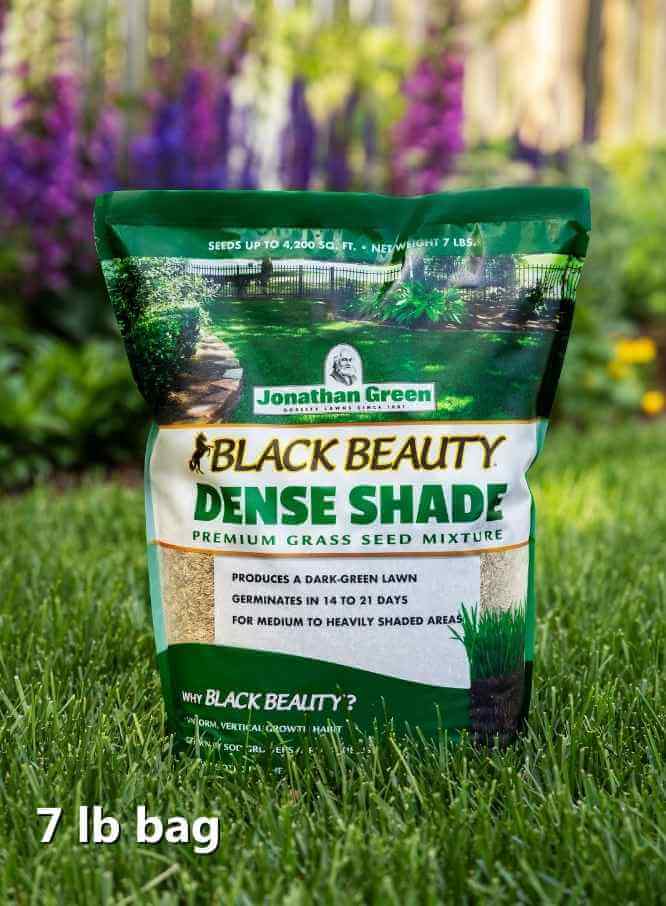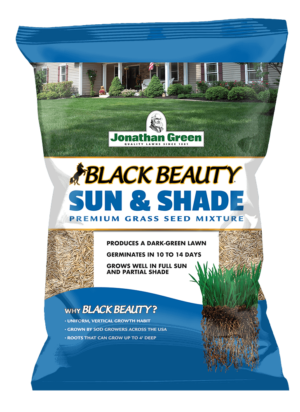Black Beauty® Dense Shade Grass Seed
$12.99 – $129.99
- Grows well in densely-shaded lawns
- Proven to grow where other shady lawn seed mixtures have failed
- Perfect for use around mature trees and shrubs where sunlight is limited
- Germinates in 14 – 21 days
Real Dense Shade Lawns
Product Overview
The Black Beauty® Dense Shade mixture contains turf-type tall fescue, perennial ryegrass and fine fescues which creates great versatility in shady to partially sunny lawns. This seed germinates in 14 - 21 days.
Coverage Guide
Coverage:
Shipping & Returns
Shipping
- Free ground shipping now available on orders of $75 or more! For smaller orders, shipping costs are calculated at checkout.
- We ship orders the same day if placed by 2PM EST (later orders will be shipped the next day).
- Orders are not shipped or delivered on weekends or holidays.
- We offer ground and expedited shipping.
Returns
- We offer 30-day free returns for replacement or full refund for items that are damaged or defective (shipping included). If damaged by the carrier, please file a claim with them.
- If your items have been used or aren’t in the original packaging, we will give you a refund (minus the cost of shipping) based on the condition of the product.
View our complete shipping and return policy. If you have questions about your order, please contact our customer service team at orders@jonathangreen.com.
-
Grass Type(s)
Tall fescues, fine fescues, and perennial ryegrass
-
When to Apply
For cool-season lawns, the best time to apply grass seed is in fall (between mid-August to mid-October), or in spring (between mid-March to mid-May). For grass seed to germinate, soil temperatures must be at least 55°F, and air temperatures should not exceed 85°F.
-
Sunlight Requirement
4+ hours of sunlight per day
-
Traffic Tolerance
Black Beauty® Dense Shade can withstand moderate traffic
-
Germination Rate
14 – 21 days
-
Use With Other Products
Dense Shade can be applied with any of our soil foods. We do not recommend applying this product with any weed controls or fertilizers high in nitrogen. Because shady lawns receive less sunlight—they require less nutrients and do not respond well to overfeeding—especially with fertilizers high in nitrogen. Use only Jonathan Green Veri-Green Starter Fertilizer for Seeding & Sodding which contains phosphorus to encourage deep root growth when seeding.
You must wait at least 30 days to seed after applying weed control. For a full list of wait times, visit this FAQ page.
-
Watering Tips
- For best germination, water seeded areas twice a day, for 5 – 10 minutes to keep the seedbed moist. Continue watering daily for a few weeks until the grass plants reach a height of 2 – 2.5 inches.
- A good rule of thumb for established lawns, is to give them one inch of water per week including rainfall. To avoid your lawn going dormant in the summer, you may need to increase your watering rate.
-
Mowing Tips
- Begin mowing your new lawn when the new grass has reached a height of 3 – 4 inches.
- Be careful not to scalp your lawn, as low mowing will stress the root system and encourage the growth of weeds. When mowing, only take off the top third of the grass blade.
-
Shelf Life
Our recommendations for storing your grass seed:
Place it in a cool dry place, off of the ground, out of direct sunlight, and keep it away from moisture. Under these conditions, grass seed will last at least two years.
-
Product Label
Always read and follow the product label before use.
Safety Data Sheets can be found at www.jonathangreen.com/safety-data-sheets-sds. If you have a specific question, do not hesitate to contact us.
Manufacturer
Step 1/4
Who makes your spreader?
Don’t see your spreader here? Contact the manufacturer or review your spreader’s manual.
Spreader
Model
Step 3/4
What is the model of your spreader?
Don’t see your spreader model here? Contact the manufacturer or review your spreader’s manual.
Rate
Step 4/4
Select the rate that best suits your lawn needs.
Depending on the type of product you selected there may only be one application rate.
Note: “New lawn” indicates that you are starting a lawn from bare dirt vs overseeding or applying product to an existing lawn.

-
Dense Shade vs Shady Nooks Grass Seed
Jonathan Green’s Black Beauty® Shady Nooks Grass Seed is our most shade-tolerant grass seed mixture. It survives well in either damp or dry soils, of up to 90% deep shade, where other grasses fail.
Black Beauty® Dense Shade Grass Seed contains shade-tolerant varieties that will grow well under trees and in up to 70% shade. It is a mixture of primarily turf-type tall fescue grasses, and therefore creates great versatility in shady to partial sun lawns, blends well into sunnier areas, and grows best in drier soils.
Black Beauty Dense Shade Grass Seed
- Grass Type: Tall and Fine Fescues, Perennial Rye, & Kentucky Bluegrass
- Grass Color: Dark green
- Sun Tolerance: Good
- Shade Tolerance: Excellent
- Light Requirements: Partial sun to shade (4+ hours of sun)
- Drought Tolerance: Excellent
- Germination Time: 14 – 21 days
- Best Use: Lawns with big shady trees, large shrubs, or areas shaded by houses or other permanent structures.
Black Beauty Shady Nooks Grass Seed
- Grass Type: Tall Fescues, Perennial Rye, & Fine Fescues
- Grass Color: Dark green
- Sun Tolerance: Good
- Shade Tolerance: Excellent – Jonathan Green’s most shade tolerant turfgrass mixture
- Light Requirements: Sun to dense shade (3+ hours of sun)
- Drought Tolerance: Excellent
- Planting Depth: ¼ inches
- Germination Time: 10 – 14 days
- Best Use: Lawns in deep shade and in damp or dry soil. Grows well right up to the base of trees, and requires less fertilizer*. Shady Nooks is the most shade tolerant turfgrass mixture on the market.
*Note: Because shady lawns receive less sunlight, they perform less photosynthesis meaning they require less food and do not respond well to overfeeding, especially with high nitrogen fertilizers. Use Jonathan Green Veri-Green Starter Fertilizer for Seeding and Sodding which contains phosphorus to encourage deep root growth.
-
How to grow grass in the shade?
Growing a lawn in the shade can be challenging. Our number one recommendation is to use a grass seed mixture designed for the shade like Jonathan Green Shady Nooks or Dense Shade.
Here are some other tips:
- Remove trees or thin out some branches to allow more sunlight to enter the area
- Apply Jonathan Green Mag-I-Cal to improve soil pH and quality
- Do not over water or over fertilize the shady parts of your lawn
- Seed in shaded areas after the fall leaves drop and are removed
Features You’ll Love
Specially Formulated for Shade

Perfect for Under Trees

How to Seed
Prepare
Mow
To ensure the seed reaches the soil, mow the lawn on the lowest setting and bag the clippings.
Rake
Use a metal rake to remove debris, rocks, and thatch that has built up. Rake vigorously to create grooves in the top layer of soil. Fill in any holes and level the ground with additional topsoil if necessary.
Amend
Test your soil pH to check that it is in a healthy range for grass plants to grow. Optimal pH for cool-season lawns is 6.2 to 7.0. For soils with a pH below 6.2, use Jonathan Green Mag-I-Cal® Plus for Lawns in Acidic & Hard Soil to rapidly raise soil pH. For a pH above 7.0, use Mag-I-Cal® Plus for Lawns in Alkaline & Hard Soil to lower soil pH.
Apply
Set
To evenly distribute grass seed, use a spreader suitable for your specific lawn size. Set the spreader according to the recommended setting on the packaging or use our Spreader Settings Tool above. Make sure to update the setting with each product you apply.
Spread
Carefully read and follow all instructions on the product labels prior to application. Before spreading, calculate the amount of seed needed for the square footage of your lawn.
For new lawns:
Start by filling the spreader with half of the grass seed. Apply the seed around the perimeter of the lawn to establish a turning area. Make straight passes back and forth across the length of the lawn in one direction (north to south) and then the remaining seed in a perpendicular direction (east to west) within the outlined area. Overlap slightly between passes and close the hopper when turning. Walk at a steady pace for even distribution. This crisscross pattern ensures even coverage and helps prevent bare spots in new lawns.
For overseeding:
Begin by spreading the seed along the perimeter of your lawn. Make straight passes back and forth across the length of the lawn in a mowing pattern until the entire area is covered. Overlap slightly between passes and close the hopper when turning. Walk at a steady pace for even distribution.
Rake
After seeding, gently rake the soil with a metal rake to incorporate the grass seed into the top quarter-inch of soil. This will improve seed-to-soil contact and promote germination.
Fertilize
Maximize seedling growth and root development by applying starter fertilizer along with the seed. Fill your spreader on a hard surface to avoid fertilizer burn. Start by applying fertilizer around the lawn’s perimeter to establish a turning area. Then, make back-and-forth passes within the outlined area, ensuring overlap for complete coverage. Sweep any excess granules off of hard surfaces and back onto the lawn.
Water
Immediately after seeding, thoroughly water the area but not to the point of run-off or puddles.
Maintain
Water
Keep the soil consistently moist by watering lightly several times a day, or as needed, to prevent drying out. Avoid excessive watering that may cause pooling or runoff. Continue watering daily for a few weeks until the grass plants reach a height of 2 – 2.5 inches. As the grass seed germinates, gradually reduce the frequency of watering while increasing the amount applied to encourage deeper root growth.
Mow
Begin mowing when the new grass has reached a height of 3 – 4 inches. Make sure the mower has sharp blades. Be careful not to scalp the lawn, low mowing will stress the root system and encourage the growth of weeds.















